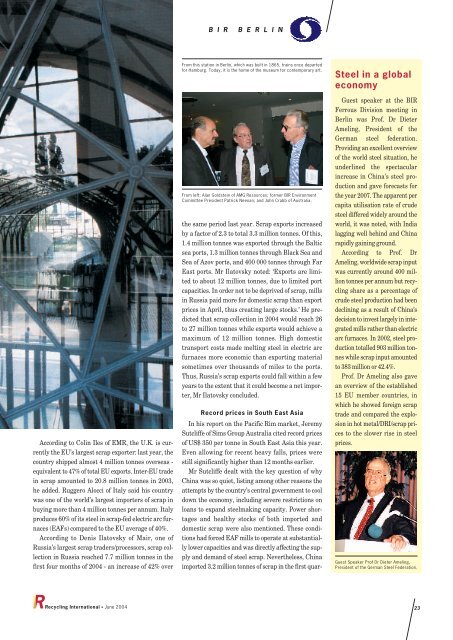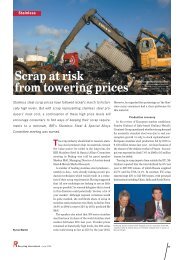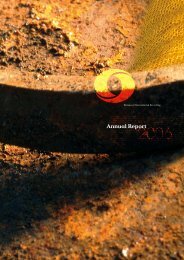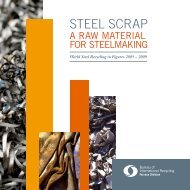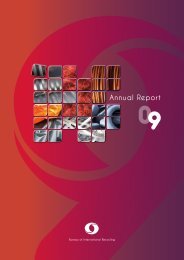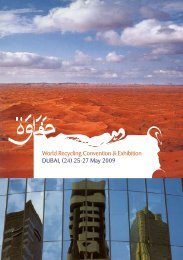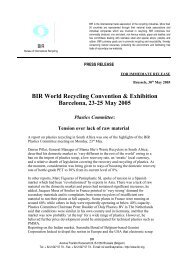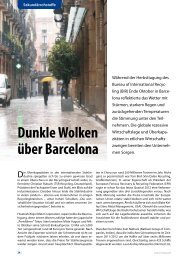You also want an ePaper? Increase the reach of your titles
YUMPU automatically turns print PDFs into web optimized ePapers that Google loves.
B I R B E R L I N<br />
According to Colin Iles of EMR, the U.K. is currently<br />
the EU’s largest scrap exporter: last year, the<br />
country shipped almost 4 million tonnes overseas -<br />
equivalent to 47% of total EU exports. Inter-EU trade<br />
in scrap amounted to 20.8 million tonnes in 2003,<br />
he added. Ruggero Alocci of Italy said his country<br />
was one of the world’s largest importers of scrap in<br />
buying more than 4 million tonnes per annum. Italy<br />
produces 60% of its steel in scrap-fed electric arc furnaces<br />
(EAFs) compared to the EU average of 40%.<br />
According to Denis Ilatovsky of Mair, one of<br />
Russia’s largest scrap traders/processors, scrap collection<br />
in Russia reached 7.7 million tonnes in the<br />
first four months of 2004 - an increase of 42% over<br />
From this station in Berlin, which was built in 1865, trains once departed<br />
for Hamburg. Today, it is the home of the museum for contemporary art.<br />
From left: Alan Goldstein of AMG Resources; former <strong>BIR</strong> Environment<br />
Committee President Patrick Neenan; and John Crabb of Australia.<br />
the same period last year. Scrap exports increased<br />
by a factor of 2.3 to total 3.3 million tonnes. Of this,<br />
1.4 million tonnes was exported through the Baltic<br />
sea ports, 1.3 million tonnes through Black Sea and<br />
Sea of Azov ports, and 400 000 tonnes through Far<br />
East ports. Mr Ilatovsky noted: ‘Exports are limited<br />
to about 12 million tonnes, due to limited port<br />
capacities. In order not to be deprived of scrap, mills<br />
in Russia paid more for domestic scrap than export<br />
prices in April, thus creating large stocks.’ He predicted<br />
that scrap collection in 2004 would reach 26<br />
to 27 million tonnes while exports would achieve a<br />
maximum of 12 million tonnes. High domestic<br />
transport costs made melting steel in electric arc<br />
furnaces more economic than exporting material<br />
sometimes over thousands of miles to the ports.<br />
Thus, Russia’s scrap exports could fall within a few<br />
years to the extent that it could become a net importer,<br />
Mr Ilatovsky concluded.<br />
Record prices in South East Asia<br />
In his report on the Pacific Rim market, Jeremy<br />
Sutcliffe of Sims Group Australia cited record prices<br />
of US$ 350 per tonne in South East Asia this year.<br />
Even allowing for recent heavy falls, prices were<br />
still significantly higher than 12 months earlier.<br />
Mr Sutcliffe dealt with the key question of why<br />
China was so quiet, listing among other reasons the<br />
attempts by the country’s central government to cool<br />
down the economy, including severe restrictions on<br />
loans to expand steelmaking capacity. Power shortages<br />
and healthy stocks of both imported and<br />
domestic scrap were also mentioned. These conditions<br />
had forced EAF mills to operate at substantially<br />
lower capacities and was directly affecting the supply<br />
and demand of steel scrap. Nevertheless, China<br />
imported 3.2 million tonnes of scrap in the first quar-<br />
Steel in a global<br />
economy<br />
Guest speaker at the <strong>BIR</strong><br />
Ferrous Division meeting in<br />
Berlin was Prof. Dr Dieter<br />
Ameling, President of the<br />
German steel federation.<br />
Providing an excellent overview<br />
of the world steel situation, he<br />
underlined the spectacular<br />
increase in China’s steel production<br />
and gave forecasts for<br />
the year 2007. The apparent per<br />
capita utilisation rate of crude<br />
steel differed widely around the<br />
world, it was noted, with India<br />
lagging well behind and China<br />
rapidly gaining ground.<br />
According to Prof. Dr<br />
Ameling, worldwide scrap input<br />
was currently around 400 million<br />
tonnes per annum but recycling<br />
share as a percentage of<br />
crude steel production had been<br />
declining as a result of China’s<br />
decision to invest largely in integrated<br />
mills rather than electric<br />
arc furnaces. In 2002, steel production<br />
totalled 903 million tonnes<br />
while scrap input amounted<br />
to 383 million or 42.4%.<br />
Prof. Dr Ameling also gave<br />
an overview of the established<br />
15 EU member countries, in<br />
which he showed foreign scrap<br />
trade and compared the explosion<br />
in hot metal/D<strong>RI</strong>/scrap prices<br />
to the slower rise in steel<br />
prices.<br />
Guest Speaker Prof Dr Dieter Ameling,<br />
President of the German Steel Federation.<br />
Recycling International • June 2004 23


